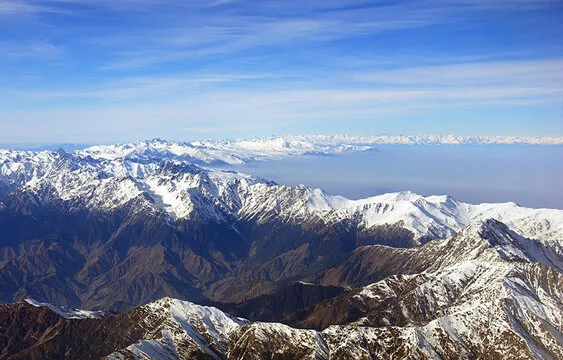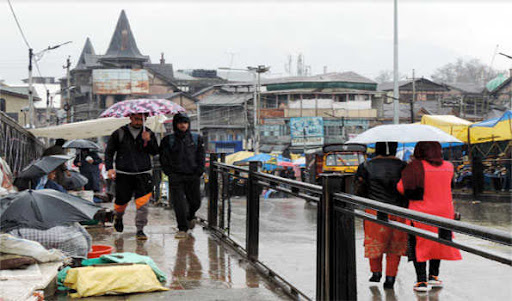Kashmir’s Higher Reaches Receive Season’s First Snowfall | Pir Panjal Turns White as Winter Arrives Early
By: Javid Amin | 03 October 2025
When the Mountains Whisper Winter
Srinagar, October 4, 2025 — It’s that time of year again when Kashmir’s mountains begin to breathe cold, and the air carries the scent of snow. The upper reaches of the Valley, including the Pir Panjal range, have received the season’s first snowfall, marking an early arrival of winter’s quiet beauty.
From Affarwat in Gulmarg to Sinthan Top in Anantnag and Pir Ki Gali along the Mughal Road, a fine layer of snow blanketed peaks and meadows, turning the landscape into a painter’s dream. The light snowfall, accompanied by rain and gusty winds across the plains, signals the beginning of a climatic transition — from the crisp gold of autumn to the serene white of winter.
For locals, this first snow is an emotional milestone — a moment of nostalgia, prayer, and preparation. For travelers, it’s an irresistible invitation to witness Kashmir’s transformation into a snow-kissed wonderland.
The Science Behind the Snow: Western Disturbance at Play
The early snowfall is attributed to an incoming Western Disturbance — a weather system that originates over the Mediterranean and travels eastward, bringing moisture-laden winds to northern India.
According to the India Meteorological Department (IMD), the current system, active from October 5 to 7, is expected to intensify and bring light to moderate snowfall across higher reaches and rain in plains, with potential heavy rainfall in parts of Jammu Division.
🔹 What Is a Western Disturbance?
A Western Disturbance (WD) is essentially a low-pressure area that carries moist air from the Mediterranean, Caspian, and Black Seas. As it collides with the cold air over the Himalayas, it produces precipitation — snow in the higher reaches and rain in the plains.
While WDs are most common in winter (December–March), the current October event signals a seasonal shift that may indicate early winter onset in Kashmir and Ladakh this year.
🔹 Why It Matters
These disturbances play a crucial role in maintaining the Himalayan hydrological cycle. Snowfall replenishes glaciers that feed major rivers such as the Jhelum, Chenab, and Indus, sustaining millions downstream. However, their increasing unpredictability due to climate change is a growing concern for environmental experts.
Forecast Highlights: What to Expect (October 5–7, 2025)
The IMD has issued detailed weather alerts for Jammu & Kashmir and Ladakh:
🌨️ Kashmir Valley
-
Snowfall: Light to moderate snowfall in Gulmarg, Sonamarg, Pahalgam, Sinthan Top, and Pir Panjal region.
-
Rain: Intermittent rain in plains including Srinagar, Budgam, Pulwama, and Anantnag.
-
Temperature: Day temperatures expected to drop by 4–6°C, bringing early morning chill and frost risk.
❄️ Ladakh
-
Snowfall: Upper reaches of Zanskar, Drass, and Leh likely to receive snow from Sunday night.
-
Visibility: Drastic drop expected due to snow flurries and fog in valleys.
-
Travel: Possible disruptions on Kargil–Leh and Srinagar–Leh highways.
🌧️ Jammu Division
-
Rainfall: Isolated heavy to very heavy rainfall likely in Doda, Kishtwar, Kathua, Ramban, and Udhampur.
-
Landslides: High probability of landslides along Ramban–Banihal stretch.
-
Thunderstorms: Accompanied by lightning and strong gusts.
Agricultural Advisory: A Race Against Time
The early arrival of snowfall poses a new challenge for Kashmir’s farming community. The Agriculture Department and IMD have advised farmers to complete apple and paddy harvesting before October 4 afternoon to minimize losses.
🔹 Apple Growers
For apple growers in Shopian, Kulgam, Baramulla, and Pulwama, the timing is critical. A sudden snowfall can damage fruit-laden trees, especially in higher-altitude orchards where harvesting often stretches into mid-October.
🔹 Paddy Farmers
Farmers in the plains of Budgam and Ganderbal are also racing against time. Prolonged rain could delay threshing and drying, affecting grain quality.
🔹 Livestock Owners
Shepherds in the upper Doda and Anantnag belts have begun moving livestock to lower pastures, anticipating freezing temperatures.
“We have learned from experience,” says Abdul Ahad, a farmer from Shopian. “Snow in October can break branches and ruin the entire year’s effort. So, we work day and night before the skies close in.”
Travel Advisory: A Pause for the Mountains
🏔️ Roads & Passes
The Meteorological Department has urged tourists, trekkers, and transporters to avoid high-altitude routes during the next few days.
-
Zojila Pass, Razdan Top, and Sadhna Pass are expected to receive moderate to heavy snowfall, which may temporarily block traffic.
-
The Mughal Road, connecting Shopian with Rajouri and Poonch, could see snow accumulation at Pir Ki Gali.
-
Ramban–Banihal stretch remains vulnerable to landslides and shooting stones.
✈️ Air Travel
-
Srinagar International Airport may witness flight delays due to low visibility.
-
Leh Airport faces potential cancellations if snow intensifies.
🧭 Tourists & Trekkers
Adventure travelers are advised to postpone trekking routes in Gulmarg, Sonamarg, Tarsar-Marsar, and Great Lakes. Local authorities may suspend mountaineering permits if conditions worsen.
The Emotional Resonance of First Snow
For Kashmiris, the first snowfall is not merely a weather event — it’s a deeply emotional experience interwoven with culture, poetry, and nostalgia.
-
In Srinagar, children rush outdoors to feel the season’s first flakes.
-
In villages, families prepare kangris (traditional fire pots) and stack wood for the cold months ahead.
-
In markets, demand for woolens, firewood, and dried vegetables spikes overnight.
“When the Pir Panjal turns white, we know the Valley will soon sleep under snow,” says Nighat, a teacher from Baramulla. “It’s beautiful but also a reminder to prepare — both body and soul — for the long winter.”
Even the Dal Lake mirrors this transformation — shikaras drift slowly through mist, their reflections softened by the haze. Saffron fields in Pampore glow against the pale skies, bracing for frost. The shift is not just meteorological; it’s deeply poetic.
Environmental Perspective: Beauty and Balance
🌱 Ecological Benefits
-
Snow acts as a natural reservoir, feeding rivers and underground aquifers during the dry summer months.
-
The first snow also kills pests and fungi, offering natural cleansing for soil and crops.
-
It signals migration patterns for wildlife — ibex, snow leopards, and migratory birds adjust to changing altitudes.
⚠️ Climate Challenges
However, experts warn that the timing and intensity of snow events are increasingly unpredictable due to climate change.
-
Erratic snowfall has been observed over the past decade — heavier bursts, shorter durations.
-
Late-season snow in spring often destroys apple blossoms and vegetable seedlings.
-
Reduced snow cover threatens glacier formation, impacting rivers downstream.
Dr. Tariq Ahmad, a climatologist from Kashmir University, explains:
“Early snowfall like this may appear romantic, but it also indicates instability in atmospheric circulation. Western Disturbances are arriving sooner and more frequently — a sign that global climate patterns are shifting.”
Cultural Significance: Snow in Kashmiri Life and Art
Snow in Kashmir is not just weather; it’s a metaphor — for purity, silence, resilience, and even melancholy.
-
Poets like Habba Khatoon and Mahjoor wrote verses about the serenity and solitude of snow.
-
Artists capture the contrast between saffron fields and white peaks.
-
Craftsmen prepare for winter’s tourism wave — papier-mâché artisans, carpet weavers, and woodcarvers create pieces that mirror the snow-clad valley.
In local folklore, the first snowfall is considered a blessing, symbolizing renewal and spiritual cleansing. For Sufis and mystics, it’s nature’s way of reminding humanity of impermanence — that every season must pass, and beauty lies in change.
Tourism Outlook: Winter Beckons
While travel advisories are in place for the short term, the first snowfall also marks the beginning of Kashmir’s winter tourism season.
-
Gulmarg, Asia’s premier ski destination, prepares to open its slopes earlier this year.
-
Pahalgam gears up for snow treks and cozy riverside stays.
-
Sonamarg, though closing soon for heavy snow, attracts early winter photographers and filmmakers.
The J&K Tourism Department has announced plans to promote “Snow Trails of Kashmir” this year — a campaign highlighting offbeat winter experiences in Yusmarg, Doodhpathri, and Bangus Valley.
“This early snowfall sets the tone for a promising winter tourism season,” said an official from the Tourism Department. “But safety remains paramount — travelers must follow advisories strictly.”
Preparing for the Days Ahead
Authorities have placed disaster response teams on standby, particularly along mountain passes and highways. Power utilities are reinforcing supply lines, and municipal departments are preparing snow-clearance machinery in advance.
Key Recommendations:
✅ Avoid unnecessary travel in hilly terrain
✅ Stock essentials — food, fuel, and medicines
✅ Keep communication lines charged and emergency numbers handy
✅ Monitor official IMD and local administration bulletins
Broader Climate Reflection: Lessons from the Himalayas
This early snowfall is part of a larger narrative playing out across the Himalayas — where climate and culture are intertwined. From the glaciers of Ladakh to the apple orchards of Shopian, the rhythm of life depends on nature’s balance.
But as climate change accelerates, this balance is under strain. Earlier snow, erratic rain, and rapid thaw cycles could reshape Kashmir’s ecosystem — altering river flows, agricultural timelines, and tourism patterns.
The need for climate adaptation policies, sustainable tourism, and resilient infrastructure has never been greater.
“The snow is beautiful, but it’s also a message,” says Dr. Ahmad. “Nature is speaking — the question is whether we are listening.”
Bottom-Line: When Silence Falls from the Sky
As the first snowflakes settle on pine needles and rooftops, the Valley slows down — not in despair, but in reflection. It’s a pause that reconnects people with the cycles of nature, faith, and home.
The Pir Panjal turning white is more than a seasonal change. It’s a reminder — that beauty and caution must coexist, that every flake carries both wonder and warning.
Kashmir’s story this October is not just about the cold — it’s about resilience, readiness, and reverence for the mountains that cradle its heart.



